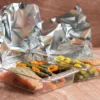Did you know that in Tibet they drink tea with yak butter and salt. Mint leaves are added to tea in North Africa, and green tea is drunk without additives in the Far East. This drink is drunk in a variety of ways, and the facts about it will surprise you.
Here are some unusual, true and fascinating facts about tea.
1. There are about 3,000 different types of tea in the world
Tea connoisseurs they say that the taste of a particular tea depends on where is growing and for what species bushes it goes. The teas available in stores are consisting of different types of teas, which are grouped together.

2. Mint tea is not tea, it is an infusion
All teas that are marked with the label tea, must originate from the leaves of the plant Camellia sinensis. All the rest herbs (eg mint) or fruit (e.g. raspberry) are merely an aqueous extract from the plant. Many companies simply give the name "tea" to tea because it is something that is put into a cup hot water, is for BuzzFeed said tea expert Kate Woollard.

3. Milk in coffee indicates social status
Drinking tea with milk is related to poor quality porcelain, they say connoisseurs. In the past, when hot tea was poured into a bad cup, it cracked. To prevent this, they poured milk. By using better quality cups, it was no longer necessary to do this. Milk in the tea it began to symbolize prestige, which the user demonstrated by using the best porcelain, and also a higher social status. Milk in tea is not the result of good taste, but prestige.

4. In the 18th century, due to its immense value, tea was kept in a locked box
Tea imported into Europe end of the 17th century, was valuable commodity, which was kept safely in locked boxes. Such boxes, which can also be found in The V&A Museum, often contained several drawers with metal boxes for storing different types of tea or sugar.

5. Additives were added to tea to make money
The author of the book on the tea tradition Lisa Boalt Richardson it is written that in the 18th century tea was also illegal imported. They are for profit smugglers thus compromising the purity of the tea, as they mixed the tea with the leaves of other plants. But they also added tree branches, sawdust and sheep manure.

6. Tea bags were invented in the early 1900s
There is quite a bit of debate as to when it was first produced tea bag. In 1901, Mrs patented by Robert C. Lawson and Mary Molaren of Milwaukee, and seven years later, American businessman Thomas Sullivan began producing tea samples in fine silk bags that customers placed directly into hot water.

7. There is a British brewing process for making the perfect cup of tea
In 1980 the British Tea Manufacturers Association, the Tea Trade Board and the Department of Agriculture, Fisheries and Food formed standards for tea preparation. If you follow these instructions, you will be able to prepare perfect tea. You need a porcelain pot. You should add two grams of tea for every 100 ml of water. Temperature should not exceed 85 degrees Celsius, for optimal taste and feeling, but it must be tea, when served, above 60 degrees Celsius.







